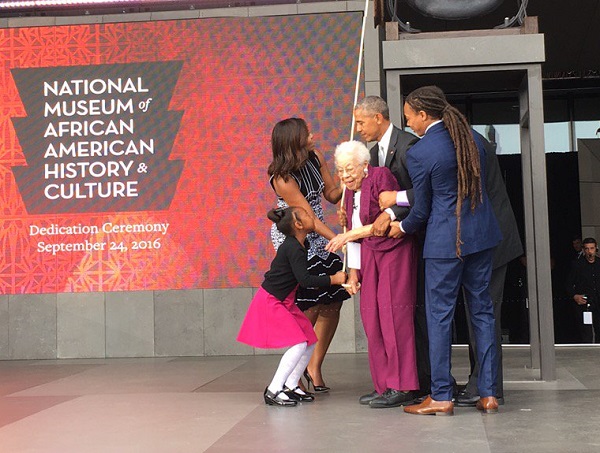
Washington, United States | AFP |
President Barack Obama heralded Saturday the opening of the National Museum of African American History and Culture, a long-awaited institution dedicated to the many threads of black suffering and triumph in the United States.
The first black president of the United States cut the ribbon to inaugurate the striking 400,000-square-foot (37,000-square-meter) bronze-clad edifice before thousands of spectators gathered in the nation’s capital to witness the historic opening.
“Beyond the majesty of the building, what makes this occasion so special is the larger story it contains,” said Obama — just a few months before he leaves office — at the star-studded public ceremony that included the likes of Stevie Wonder and Oprah Winfrey.
“African-American history is not somehow separate from our larger American story. It’s not the underside of the American story,” he said. “It is central to the American story.”
The Smithsonian’s 19th and latest addition to its sprawling museum and research complex is the first national museum tasked with documenting the uncomfortable truths of the country’s systematic oppression of black people, while also honoring the integral role of African-American culture.
“A clear-eyed view of history can make us uncomfortable,” Obama said. “It is precisely of that discomfort that we learn and grow and harness our collective power to make this nation more perfect. That’s the American story that this museum tells.”
Guests of honor on stage included four generations of a black family called the Bonners, led by 99-year-old great-grandmother Ruth, the daughter of a slave who went on to graduate from medical school.
After Obama declared the museum “open to the world,” it was she — stooped in stature but smiling broadly — who tugged on a rope to ring an antique bell from an historic black church, sealing the inauguration.
“I feel a sense of pride and a sense of humbleness because of all the sacrifices that so many people made to make this happen,” said audience member Karmello Colman, who trekked halfway across the country for the ceremony from Kansas City, Missouri.
“I feel honored because it is highlighting the accomplishments of my ancestors, who were probably slaves, and those of so many others.”
Deteriorating race relations
Elected in a wave of optimism in 2008, Obama pledged to unify, often repeating that he is not the president of black Americans but of all Americans.
But as his job as president ends, polls show that the overwhelming majority of Americans see US race relations as “generally bad.”
The recent fatal police shootings of black men in Tulsa, Oklahoma and Charlotte, North Carolina laid bare yet again the country’s racial disquiet.
Obama’s Saturday address to open the museum came amid these ever-heightening tensions, as national outrage grows over the spate of deaths of black men at the hands of police, prompting mass protests.
The president emphasized that a museum alone cannot solve the ills of a country still struggling to overcome a dark legacy of racial prejudice, but said it “provides context for the debate of our times.”
“Perhaps it can help a white visitor understand the pain and anger of demonstrators and places like Ferguson and Charlotte,” Obama said.
“It can also help black visitors appreciate the fact that not only is this younger generation carrying on traditions of the past, but within the white communities, across the nation, we see the sincerity of law enforcement officers and officials who, in fits and starts are struggling to understand.”
“And are trying to do the right thing,” he said.
‘Hallowed ground’
The dramatic building — set in a prime location near the White House and the Washington Monument — features three inverted-pyramid tiers sheathed in bronze-painted filigree panels that house more than 34,000 objects, nearly half of them donated.
Obama noted that the building reaches 70 feet below ground — “its roots spreading far wider and deeper than any tree on this mall” — a crypt of historical galleries that wind from slavery to civil rights and ascend into upper floors that include testaments to African-American cultural contributions.
The museum’s genesis was fitful. After years of false starts and political warfare, legislation co-sponsored by John Lewis — a major leader of the civil rights movement and US congressman representing Georgia — finally was approved by Congress, paving the way for the museum. The bill was signed into law by Republican President George W. Bush in 2003.
Ringing up to $540 million — half of which was raised from private donations — the museum shows “that this country born of change, this country born of revolution, this country of we the people, this country can get better,” Obama said.
“It is a monument, no less than the others on this mall, to the deep and abiding love for this country and the ideals upon which it is founded. For we, too, are American.”
 The Independent Uganda: You get the Truth we Pay the Price
The Independent Uganda: You get the Truth we Pay the Price



